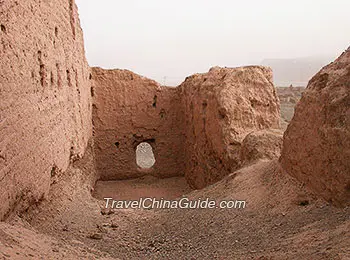Kizil Thousand-Buddha Caves
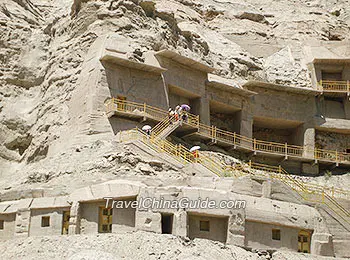
Qiuci's geographic location became to be the center of Buddhism in the West Region as well as a key point for propagating Buddhism in the Central China. Before it was taken place of by Islam in 13th century, Buddhism prevailed in Xinjiang for more than one thousand years. This explained why caves or grottos, an important medium of Buddhist arts, which illustrated sutra by architecture and murals, have been found in Xinjing.
The Kizil Thousand-Buddha Caves come in two forms, one as living quarters with earthen bed and simple facilities, and the other one as temple for worshiping. Caves of different form and function were combined into one unit. It is assumed that one unit was one temple. This is to say that temples stood shoulder to shoulder in the Kizil Thousand-Buddha Caves at that time.
The murals in the Kizil Thousand-Buddha Caves are reputed as "The most beautiful murals in Central Asia". They are found in 81 caves with a total area of more than 10,000 square meters (11,960 yards). The diamond grid pattern is the most impressive feature. There is a story about Buddha's reincarnation in every gird. Each story was portrayed by a single picture instead of a series of pictures as in Mogao Grottoes.
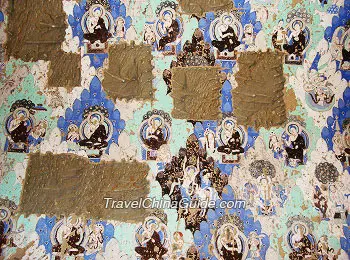 | | Colorful Mural, Kizil Thousand-Buddha Caves | | 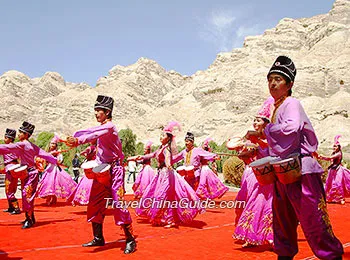 | | Fourth Qiuci Culture and Tourism Festival | |
| Admission Fee: | CNY 55 for Guxi Area
CNY 55 for Gudong Area |
Subashi Ruins
The ruins of the Subashi Temple, Subashi Ruins, are located 23 kilometers (about 14 miles) northwest of Kuqa County, Xinjiang Province. It was added to the World Heritage List on June 22, 2014.
The Subashi Ruins occupy a relatively large area, divided by Kuqa River into eastern and western areas. The eastern area is over 530 meters (about 580 yards) long and over 140 meters (about 153 yards) wide and the western area is over 680 meters (about 744 yards) long and 170 meters (about 186 yards) wide. The extent of the ruins reflects the temple's past brilliance.
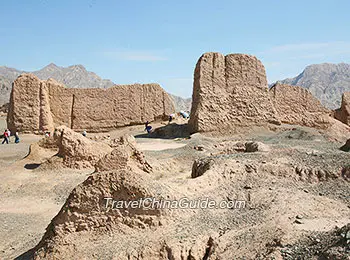 | | Subashi Ruins, Kuqa County | | 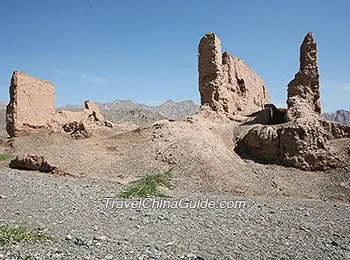 | | Ruins of Subashi Temple | |
Subashi Temple witnessed the development and the height of splendor of Buddhism in this land. The temple was built in the first century and reached its peak during the sixth to the eighth centuries in the Sui and Tang dynasties. In the Tang Dynasty (618 - 907), on passing by on his way to India to obtain Buddhist sutra, the hierarch Xuanzang was so impressed by the splendor of the temple and the popularity of Buddhism in this area that he stayed for more than 2 months. During later years, the temple had over 10 thousand monks and many hierarchs came from the interior of China to promote and develop Buddhism. Unfortunately, wars of the ninth century destroyed the temple, and it never recovered. It was finally abandoned in the thirteenth to fourteenth centuries when Islam was introduced to Xinjiang and began to prevail.
Today only the ruins of this temple remain. The pagodas, murals, walls and archaeological discoveries bear witness to the years of change, the stories of Buddhism and the development of civilization in this vast land.
- Last updated on Aug. 15, 2025 by Demi Li -
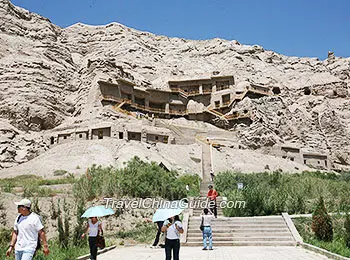
 Qiuci's geographic location became to be the center of Buddhism in the West Region as well as a key point for propagating Buddhism in the Central China. Before it was taken place of by Islam in 13th century, Buddhism prevailed in Xinjiang for more than one thousand years. This explained why caves or grottos, an important medium of Buddhist arts, which illustrated sutra by architecture and murals, have been found in Xinjing.
Qiuci's geographic location became to be the center of Buddhism in the West Region as well as a key point for propagating Buddhism in the Central China. Before it was taken place of by Islam in 13th century, Buddhism prevailed in Xinjiang for more than one thousand years. This explained why caves or grottos, an important medium of Buddhist arts, which illustrated sutra by architecture and murals, have been found in Xinjing.
